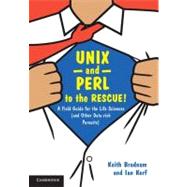
Note: Supplemental materials are not guaranteed with Rental or Used book purchases.
Purchase Benefits
What is included with this book?
| Introduction and Background: | |
| Introduction | |
| How to use this book | |
| Installing Unix and Perl: | |
| What do I need in order to learn Unix and Perl? | |
| Installing Linux on a PC | |
| Installing a code editor | |
| Essential Unix: | |
| Introduction to Unix | |
| The Unix terminal | |
| The Unix command prompt | |
| Your first Unix command | |
| The hierarchy of a Unix file system | |
| Finding out where you are in the filesystem | |
| How to navigate a Unix filesystem | |
| Absolute and relative paths | |
| Working with your home directory | |
| The Unix shell | |
| Environment variables | |
| Introduction to command-line options | |
| Main pages | |
| Working with directories | |
| The importance of saving keystrokes | |
| Moving and renaming files | |
| Moving and renaming directories | |
| How to remove files | |
| How to copy files and directories | |
| Working with text files | |
| Introduction to aliases | |
| Editing text files | |
| Automating Unix commands | |
| How to hide files and find hidden files | |
| Creating a configuration file | |
| Programming with Unix | |
| Unix file permissions | |
| How to specify which directories contain programs | |
| Creating useful shell scripts | |
| Unix summary | |
| Essential Perl: | |
| Hello world | |
| Scalar variables | |
| Use warnings | |
| Maths and functions | |
| Perl vs perl | |
| Conditional statements | |
| Use strict | |
| Stopping programs | |
| Working with strings | |
| Dealing with special characters | |
| Matching operators | |
| The transliteration operator | |
| List context | |
| Introduction to arrays | |
| Array manipulation | |
| The @ARGV array | |
| Defined and undefined variables | |
| Sorting | |
| Introduction to loops | |
| More loops | |
| Loop control | |
| Data input and output | |
| Reading and writing files | |
| Introduction to hashes | |
| Working with hashes | |
| Introduction to regular expressions | |
| Regular expression metacharacters | |
| Working with regular expressions | |
| Interacting with other programs | |
| Using functions and subroutines | |
| Returning data from a subroutine | |
| Part IV summary | |
| Advanced Unix: | |
| Introduction to advanced Unix | |
| Introduction to process control | |
| The grep command | |
| Viewing, and controlling, program output | |
| Redirecting input and output | |
| Standard error | |
| Connecting commands with pipelines | |
| Advanced text manipulation | |
| Advanced Perl: | |
| Regular expressions revisited | |
| Function libraries | |
| References and 2-dimensional arrays | |
| Records and other hash references | |
| Using references with subroutines | |
| Complex data structures | |
| Adding command-line options | |
| OOP basics | |
| CPAN | |
| Programming Topics: | |
| Debugging strategies | |
| Common error messages | |
| Code beautification | |
| Abstraction | |
| Data management | |
| Documentation | |
| Revision control | |
| Working with other peoples' data | |
| Getting help | |
| Appendix | |
| Index | |
| Table of Contents provided by Publisher. All Rights Reserved. |
The New copy of this book will include any supplemental materials advertised. Please check the title of the book to determine if it should include any access cards, study guides, lab manuals, CDs, etc.
The Used, Rental and eBook copies of this book are not guaranteed to include any supplemental materials. Typically, only the book itself is included. This is true even if the title states it includes any access cards, study guides, lab manuals, CDs, etc.